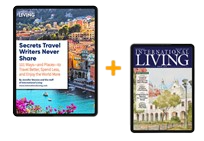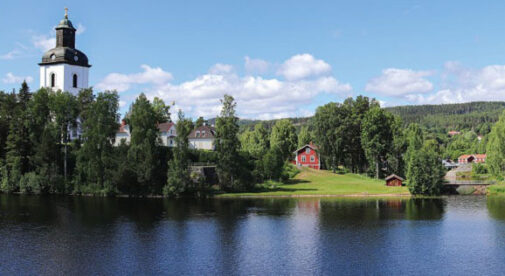People often think my husband Keith and I were crazy to swap our sandals and life in sunny Portugal for snow boots and extreme winters in Sweden. But we see it all as part of the expat adventure.
Our expat journey started in 2012 when Keith and I moved to Portugal. We lived in a variety of homes and regions, learned the language, and even became Portuguese citizens. And we traveled. As any expat living abroad—especially in Europe—can tell you, easy and economical access to neighboring countries is a major plus.
During our travels, we had only the briefest brush with Sweden. While touring Copenhagen one day, we drove over the Öresund Bridge into Malmö (about a 15 minute drive). Naturally, the few hours we had in Sweden barely gave us a hint of what it offers. When we later met a friendly Swedish couple on vacation in the Algarve and began comparing countries, we decided to pull up stakes and check Sweden out.
Are you interested in retiring abroad? Yes | Not Sure Yet
As far as the capital cities are concerned, the combined metro and urban populations of Lisbon and Stockholm are comparable at about 3.5 million. Both have a cornucopia of cultural offerings, bars and restaurants, all kinds of shopping, and fine transportation systems. Real estate prices are similar, but the overall cost of living in Stockholm is roughly 30% higher than if you were to live in Lisbon.
For our Scandinavian adventure, we opted not to live in the city. Instead, we chose the Ljusdal municipality of central Sweden, to live among locals, as we had done in Portugal. Our only neighbors for miles in this heavily forested region are a Swedish family living here part time and a German man who raises chickens and employs a crew in the summer berry-picking season, when lingonberries and blueberries are in abundance. We have yet to encounter a bear here—even though we live among the highest ursine population in all Sweden. But we’ve spotted moose, foxes, and wolves on our property, which lies across the road from a picturesque lake.
Here we discovered house prices are considerably lower than in the cities. In fact, we purchased our property with two buildings on it for about half the price of our quinta in central Portugal—about $90,000. One structure is a farmhouse dating from 1906, which needed—and could still use—some work. Like its older sibling, the other building, built in 1992, shares the same appearance, painted a traditional bright red with doors and windows trimmed in white.
Another difference, is that in Portugal even in the countryside it’s common to be able to stroll to the nearby village, which will have a café and a local market. That is not the case where we are in Sweden. Our nearest town, Los, is a half-hour drive away, and several more are an hour or so in other directions, so we plan outings and grocery shopping trips carefully.
Adjusting to a New Culture
We moved here two and a half years ago, and to be honest, it’s a world away from life in Portugal… both geographically and culturally. The Swedes have lots of traditions and social norms that are very different from life in Portugal. But that’s what makes living here fun.
A guiding principle in the Swedish mind is the concept of lagom. The “Lagom Way” encompasses moderation, modesty, and refraining from exaggeration or bragging. There’s an essential “middle-of-the-roadness” inherent in it, which ties in with the fact that Swedes by nature are reserved.
In Portugal, even new acquaintances often hug each other. Not so here. Although if you meet someone with whom you are not already acquainted, you are expected to shake hands—to not do so may be regarded as an insult.
Although the Portuguese appear taciturn at first, get a local started in a conversation and you may well spend a couple of hours in discussion. Swedish people, on the other hand, prefer not to engage in small talk. In fact, their word for it is kallprat, literally “cold talk.” They believe conversation should be productive. But raising controversial issues is frowned upon. If you do get involved in a close encounter of the conversational kind—say, in an elevator—talking about the weather is acceptable. But only for a minute or two, or you may be considered pladdrig, or “babbly.”
If all this seems off-putting, consider this: the Swedish way is aimed at avoiding confrontation and displaying respect for others. For example, if someone is upset with a neighbor—perhaps one who blasts music late at night—the accepted way of dealing with it is to write an arg lapp, or “angry note.” It’s expected that the offending party will take the hint and turn down the volume.
Our property, with two buildings, cost $90,000.
Courtesy extends to removing shoes before entering someone’s home (even in good weather)… not jumping in front of someone else in line… and inviting guests on a “house inspection walk,” or gåhusesyn. It also means not being late. If you can’t be on time, the protocol is to text an explanation and ETA, hopefully no longer than five minutes after the appointed time.
Fermented Herrings and Wine in a Box
Food is a big part of life in Sweden. January 1 is Big Pizza Day, a practice instituted in 2008 as a brilliant marketing scheme by an online pizza-delivery service. By far the favorite type of pizza here is kebab pizza—regular pizza with tomato sauce and cheese topped with kebab meat and more sauce. (The Swedes love sauces on everything and have an endless array of them in little squeezy tubes in the supermarkets.)
Waffle Day is celebrated annually on March 25, while August brings kräftskiva (crayfish) parties and the third Thursday of the same month is Surströmmingspremiär, Fermented Herring Day. On a weekly basis, Swedes routinely enjoy Taco Fridays.
You won’t catch many self-respecting locals skipping their daily fika—coffee with cake or cookies. Some businesses organize weekly Friday fikas. But note, if you join anyone for fika, make sure you don’t take the last cookie or piece of cake. It’s an old tradition to reflect that the host has provided enough for all guests.
When it comes to other beverages, while some beer can be bought at grocery stores and supermarkets, anything containing more than 3.5% alcohol is available only at the state-run Systembolaget stores. This was a big change from the easy availability of wine, beer, and liquor in stores everywhere in Portugal. Sweden’s favorite drink is not beer or hard liquor, but wine, and more than half of what is sold through “Systemet” is packaged in three-liter boxes.
Seize the Season
Despite having lived near the Canadian border and in the snowy northwest of the U.S., we have found it a challenge to navigate Swedish winters.
One factor is the light; it seems unnatural for the sun to set at 3:30 p.m. and not reappear until almost 9 a.m. On the other hand, that happens only in the deepest part of winter (December and January). But you will find yourself dealing with snow and ice for six or seven months of the year. I certainly wish I had known earlier on about those handy little ice-grippers that the wise strap onto their boots when the weather turns wild. (If I had, I would have avoided executing an inadvertent triple axel on a Stockholm street a month into our life here.)
While you may not consider living full-time here in view of the winter climate, you should know that summer is glorious in Sweden. More than two-thirds of the country is forest. And with mountain ranges, three seas, the islands of the archipelagoes, and more than 97,000 lakes, it offers almost limitless opportunities for fishing, hiking, canoeing, and if you’re the hardy sort, swimming, as water temperatures are famously brisk.
During the cold, wet winters, the days are short and nights are long and dark. So, great emphasis is placed on the concepts of trivel (well-being, satisfaction, and belonging) and mysig (calm, cozy, and snug). A critical part of achieving this ambience is the use of light, including placing small lamps in windows, trimming the outside of homes and businesses with lights, and the pervasive use of candles in both private and public places.
When summer comes, it is inconceivable to the Swedish mind to stay inside. Every opportunity to enjoy the long, sunny, days of June, July, and August must be seized! You must passa på—take advantage of all you can, not just seize the day, but the season.
In a sense, what we’ve done is not just seize the day or season, but the country.
GETTING TO SWEDEN FROM THE U.S
U.S. citizens can stay in Sweden for 90 days with just a passport. If you’d like to extend that, you’ll have to apply for a visa from the Swedish immigration agency, Migrationsverket.
When To Come
The winter months of November to February/March, are ideal for sports like skiing, snowmobiling, dog sledding, ice skating, and seeing the Northern Lights farther north.
Spring and fall are the rainy seasons and the weather can be quite chilly, but it’s warmer than winter and less touristy than in June, July, and August.
Temperatures in the summer months range from roughly 65 F to 85 F. It’s the perfect time to participate in water sports, berry picking, and Swedish nightlife. As with the Northern Lights in winter, the upper region offers something special in summer: the legendary midnight sun.
How to Get There
Getting to Stockholm’s Arlanda Airport from major U.S. cities is easy.
From Los Angeles travel time is about 15 hours (with one stop). United/Lufthansa fly to Stockholm and depart LA at 6:40 p.m. and arrive in Stockholm at 5 p.m. the following day (there’s a nine-hour time difference). The cost is around $1,475 roundtrip.
From New York’s JFK on American/Finnair it’s 11 hours (also with one stop) and costs about $1,100.
From Pearson International in Toronto, Iceland Air has a direct 10-hour flight to Stockholm for around CAD $1,250.
Arlanda Airport is outside of Stockholm, but it’s easy to get to the city center by bus, train, or taxi. Once in Stockholm, you will find lots of public transport options, including a well-designed metro system (a word of warning, the metro system ticket machines often don’t take cash so you’ll need a card to pay your fare).
Highways are well marked and outside of Stockholm, mostly toll free, so if you’re getting out of the city, you may consider renting a car. The cost of gas at the time of this writing is $1.59 per liter (about $6 a gallon). Diesel is more expensive. Check current rates at a discount gas station.

Get Your Free Report on Europe Here:
Learn more about countries in Europe and other countries from around the world in our daily postcard e-letter.
Simply enter your email address below and we'll also send you a FREE report - All the Charm and Romance of Europe…at a Price You Can Afford.
Related Articles
Podcast: Sweet on Sweden – An Inside Look at Scandinavian Life
Schengen Visa: What Countries Are in the Zone?
The Best Towns and Cities to Retire in Europe
Upcoming Conferences
The Only 2024 Fast Track Panama Conference
If your dream retirement involves stunning beaches… lush green mountains… a warm climate with no hurricanes… first-rate healthcare… incredible value for money (a couple can live well on $2,200 a month)… and the World’s #1 Retiree Discount Program…
Join our Panama experts and expats in February and discover why Panama could be your perfect paradise.
REGISTER NOW, SEATS LIMITED: EARLY BIRD DISCOUNT HERE



.png)